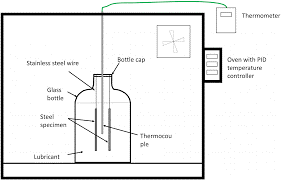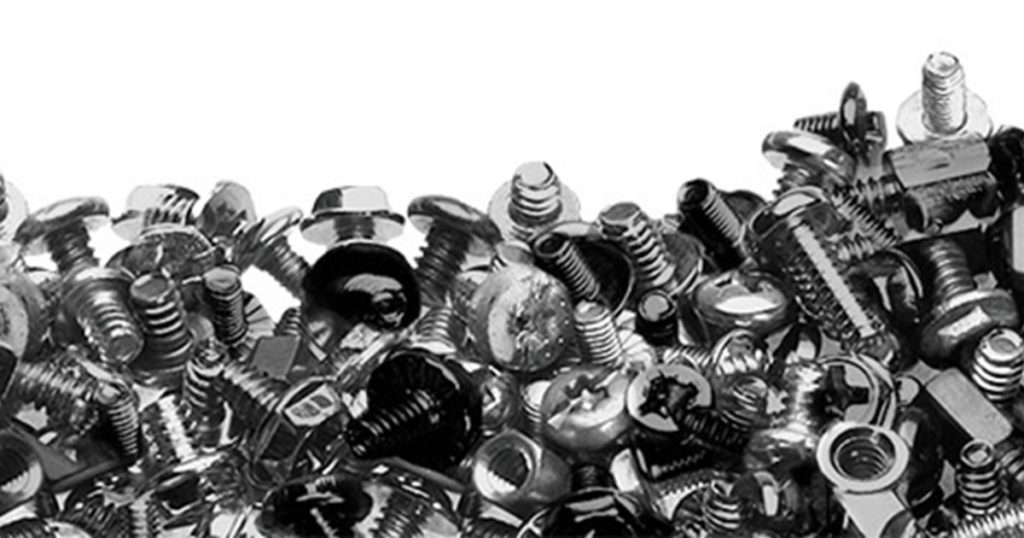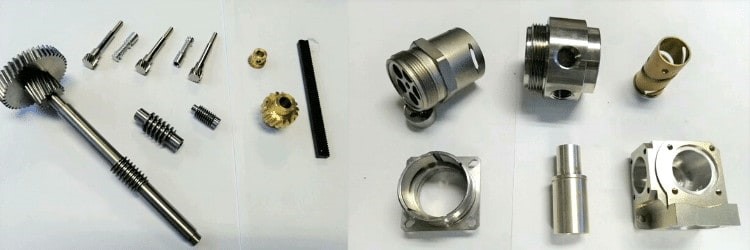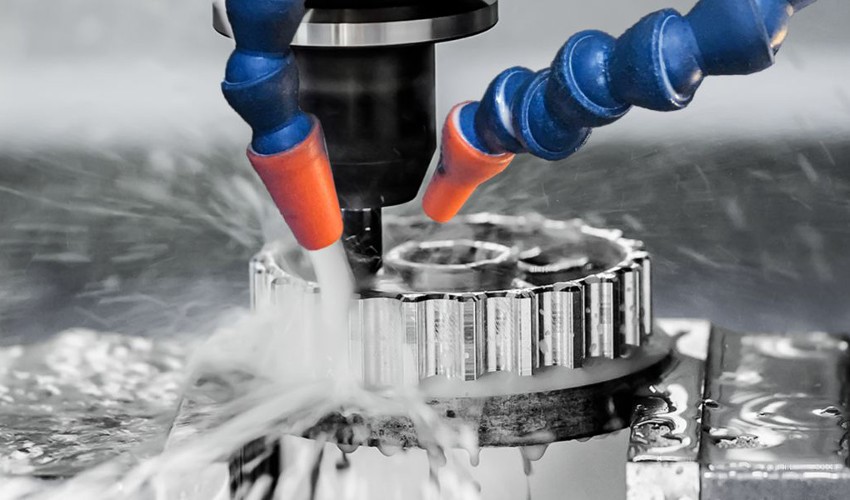Today, manufacturers carry out surface treatments on parts to improve the aesthetic properties and functionality of these components. The number of surface finish types available for custom parts is endless. However, only a few can boast of being ahead of the black oxide finish. This type of finishing or surface treatment is popular due to several reasons.
For example, the black oxide coating process transforms the exterior of metal alloys such as steel, stainless steel, copper, zinc, and other ferrous metals. It improves their corrosion resistance and ultimately blackens their surfaces. In this article, we will break down the black oxide process, the different types, and their applications. You will also learn expert tips for getting the best black oxide finish while saving costs and energy.
What is Black Oxide?
Black oxide is one conversion coating type that offers metal parts with an improved matte black appearance. A conversion coating describes a process that occurs through an electrochemical or chemical treatment of the surface in question.
As for black oxide, the coating forms from a chemical reaction after immersing parts in an alkaline aqueous salt solution. Usually, the process takes place at approximately 285 degrees F.
The reaction that takes place between the iron present in the ferrous metal alloy and the oxide bath produces a compound called magnetite. The magnetite deposits on the surface of the component to impart the surface finish.
Black oxide finish does not only improve the appearance of parts but also enhances their dimensional stability. It also reduces light reflection on the surface, which is an important requirement for parts involved in radiation.
When you black oxide steel, the thickness of the steel increases. Although this might be a tiny increase, it helps sharpen up materials like screwdrivers and drills.
The Black Oxide Finish Process
Generally, there are five simple yet important steps for black oxide coating. These include cleaning, rinsing, applying the black oxide, rinsing, and supplementary coating.

It may be necessary to include steps like alkaline descaling and acid pickling if there are scales or rusts on the parts. These steps would be important before the black oxide finish process. Parts that have bling holes will also require neutralizing and/or secondary rinsing. This will help eliminate bleed-outs or “flowering.”
Every plating on the components has to be stripped before the application of black oxide coating. The supplementary coating, i.e., the after-finish on the metal part, will dictate the overall appearance of the part. It will also have a significant effect on the function of that component.
Whenever there is a drawing or a print that specifies “Black Oxide” and leaves out an after-finish, the interpretation thereof is “Black Oxide and Oil.” Black oxide coating tends to have very poor corrosion resistance when there is no after-finish. However, the inclusion of oil, lacquer, or wax ensures excellent corrosion protection.
Black oxide steel can offer superior results with adequate supplementary coatings. The corrosion protection for black oxide stainless steel and brass is top-quality, primarily because of their inherent properties. It is essential to note that the part’s configuration and its end-use will determine the after-finish. An oil after-finish will give a glossy appearance.
On the other hand, after-finish with wax will be more matte. Black oxide finish also enables the use of torque wax to provide parts with added lubricant properties, which is great for screws, bolts, and similar components.
Types of Black Oxide Finish for Precision Machined Parts
Manufacturers currently use many different surface finishing processes to achieve the black oxide coating on metals. However, there are two broad categories of black oxide. They are the hot and cold blackening processes. Each of these categories comes with unique formulations for the proprietary coating to complete the surface treatment. Here, we will look at these two categories in detail.
Hot Black Oxide Finish Process
Also referred to as hot blackening, this process involves forming black oxide coating on parts immersed into boiling aqueous alkaline solutions of salts. That is, the manufacturer typically submerges the component in an oxidizing salt bath at a high temperature. It usually includes a hot bath of nitrates, sodium hydroxide, and nitrites.
The process is carried out after proper cleaning of the part. The hot black oxide finish process is the most popular type of black oxide coating. It takes place in industrialized settings, requiring using caustic chemical compounds. The recommended temperature range of the alkaline solution is usually 275 – 295ºF.
The salts content in the bath determines the boiling temperature. Temperatures over 295ºF will turn the obtained oxide coating red and rusty. On the other hand, temperatures below 275ºF show low salt concentration which results in an oxidizing process that is too slow. In this type of black oxide finish, you can adjust the boiling temperature by either adding salts (to increase the temperature) or diluting the solution (to decrease the temperature).
The stages of the hot black oxide finish process are as follows:
- Cleaning. It involves the mechanical cleaning and degreasing of the part in an alkaline solution.
- Water rinsing. The part is rinsed with distilled water immediately after cleaning.
- Pickling. This refers to the acid cleaning stage where rust stains and oxide films are dissolved in acid.
- Water rinsing. Another rinsing stage follows after the dissolution of stains and films.
- Black oxidizing. Immersion of the part in the hot alkaline bath for a period of 5 to 40 minutes.
- Water rinsing using a pressurized water stream.
- Drying.
- After-finish treatment. Here, the manufacturer seals the oxide surface with oil, lacquer, or wax. This imparts desired aesthetic appearance and improves the corrosion resistance of the component.
Cold Black Oxide Finish Process
The cold black oxide coating is a blackening treatment that can take place at normal room temperature. It is similar to the hot process in that it follows the general principle of depending on the chemical reactions that take place on the metal surface. This process is quite different from the hot blackening process because it does not involve oxide conversion. Instead, it involves the use of deposited copper selenium in the alteration of its product.
It is a non-conversion finish deposited from a phosphoric acid solution. This solution contains copper and selenium compounds. The cold black oxide finish is softer than the traditional black oxide coating. Although this process is easier to implement, it may not generate top-quality aesthetic properties.
Materials for Black Oxide Finish
Black oxide coating protects several ferrous metals, steel, and stainless steel parts. However, manufacturers have additionally developed specialized coatings to make black oxide finishes on copper and zinc components.

Although this metal surface finishing process may occur in low-tech environments through trial and error, it is important to have some equipment at hand. For instance, manufacturers that tend to generate parts in high volume will need:
- Blast furnaces
- Temperature control systems
- Salt baths
- Mechanized cleaning and rinsing facilities
Automation also goes a long way in helping manufacturers generate large amounts of black oxide-coated components. Furthermore, it is important to remember that black oxide finishes go along with treatments with oil, wax, lacquer, and acrylic. This further enhances the part’s resistance to corrosion.
Common Applications for Black Oxide Finish for Precision Machined Parts
Black oxide has a wide variety of use in different industries. The reason for this is not far-fetched. This finishing process provides the corrosion resistance and strength required on the battlefield and the essential functioning needed for surgical and medical tools. It is a versatile finish for several different materials.

Some of the common applications of black oxide include, but are not limited to, the following:
- Components for military applications that must meet certain specifications such as gun components and shotgun shell magazines
- Surgical instruments in light-sensitive conditions
- Hardware tools used in assemblies such as fasteners, cutting tools, gauges, shafts, bearings, springs, etc.
- Electrical components such as cutters, gears for timers and electrical switches, and wire strippers
- Automotive parts like under the hood fasteners and cans for oil filters
Pros and Cons of Black Oxide Finish
Applying a black oxide coating on materials offers several different benefits, ensuring smoother operations of devices and components. However, this finishing process also comes with some downsides, which are important to note. Here, we will examine the various merits and demerits of black oxide in custom manufacturing.
Pros of Black Oxide Finish
- It protects parts and components from corrosion after applying an after-finish to provide a reliable and long-lasting finish.
- You will get a high-quality black aesthetic appearance to parts at relatively low costs.
- It provides a clear and quality finish without compromising the parts’ dimensions.
- It is a cost-effective solution, being far less expensive than the likes of electroplating, powder coating, and painting.
- A black-coated metal part can be easily welded.
- You can apply black oxide finish in large batches of components, making it suitable for prototype manufacturing.
- It offers improved lubrication characteristics.
- There is no hydrogen embrittlement with the black oxide process.
- It conforms to several specifications of various industries.
Cons of Black Oxide Finish
- A black oxide coating can easily rub off
- May involve some extra steps that are labor-intensive
- The black look may deteriorate quickly in hot conditions, causing premature rusting.
RapidDirect: Your Preferred Partner for Precision Machining Projects
Whenever you are ready to discuss your next custom manufacturing project, RapidDirect is ready to serve you. Our clients in several different industries specify the black oxide finish for many of their precision machined parts. These include retail appliances, automotive and aerospace parts, military and defense components, medical tools, and several others.

RapidDirect is an ISO9001:2015 certified manufacturing company, and we utilize the expertise of our qualified personnel to provide the best black oxide finishes. Regardless of the complexity of your project, you can be sure of getting the best results. All of our services come at competitive rates. All you need to do is upload your design file and get an instant quote.
Testing Options for Black Oxide Finish
There are several different testing options available for a black oxide coating. If there is a need for testing, the designer will specify it on the design file. However, testing may incur additional time and cost. The most common testing options for black oxide include the following:
- Smut test – this test helps to determine if there is any black powdery residue on the part. It also checks if some of the black coatings wipe off whenever the part is rubbed by hand. Thus, it is best to carry out this test before the application of an after-finish.
- Relative humidity test – this process tests for corrosion resistance with standard practices put in place. It tests the water resistance of the black oxide coating in 100% relative humidity.
Important Factors to Consider When Specifying Black Oxide Finish for Your Machined Parts
You need to consider a number of factors before you opt for black oxide steel or coating for other metals. Considering these factors will help you make the best-informed decisions for your product. Some of these factors include the following:
1. Duration of Protection Required
You need to ask yourself, how long do I want this product protected? Your answer to this question will help you decide if the black oxide is the option for the product. Generally, black oxide coating offers remarkable corrosion resistance properties to the component. Therefore, you can be sure of long-term protection. However, the duration of protection also depends on other factors, which we will mention soon.
2. Final Application of the Part
Are you making precision machined parts for the military or aerospace industry? Or are your parts intended for use in the automotive or medical industry? These are questions you should already have answers to. Therefore, your manufacturing decisions will depend on the answers to the questions. Ultimately, the black oxide finish is a versatile one, and it fits different applications in different industries.
3. Application Environment
Black oxide-coated metal parts are usually able to withstand a wide range of conditions. However, you still need to consider if the part will be used indoors or outdoors. Parts used indoors often last longer than those for outdoor use. However, environmental conditions like temperature, humidity, and vapor may also affect the durability of the coating. Hot black oxide finish tends to wear off faster in high-temperature environments. Therefore, it will be best to take this into consideration.
4. Desired Aesthetic Appearance
Components used in certain applications are expected to come with some quality aesthetic finish. Some parts may require a matte or glossy finish. This will affect how thick the application of the black oxide will be. So, the desired finish appearance is another crucial consideration.
Black Oxide Finish FAQs
Black oxide is one of the most durable finishing techniques for ferrous metals. It helps to avoid the chipping of the metals and imparts overall corrosion resistance on the parts. It provides just about ten-millionths of an inch to the metal’s dimensions. Thus, the component retains its dimensional features, and there are no compromises to quality.
For maximum resistance against rusting or corrosion, manufacturers apply after-finishes to the components. These could involve waxing, oiling, or adding lacquer. While the wax coating may cause the color of the treatment to be dull, it also offers the best form of resistance to rusting.
The black oxide coating is perfect for metal materials, so you may find manufacturers using it after sheet metal fabrication processes. It is most suitable for non-ferrous metal alloys, but it finds use in other metal parts. You can use black oxide finish on the following metals:
Stainless steel
Steel
Cast iron
Zinc
Copper
Nickel
Brass
Cadmium
Most metal finishing processes utilize toxic chemicals. However, the black oxide process comes with some concerns about hazards. One of the reasons for this harmfulness in black oxide is the operation of the bath at about 295ºF. Therefore, only experts with enough experience must handle the black oxidize process.
Black oxide provides only mild corrosion resistance despite the black finish. Furthermore, the black zinc finish is thicker than black oxide. Thus, it might affect the overall dimensions of the part. It is, therefore, essential to be wary of black zinc for high-tolerance or tight-fitting parts.
Conclusion
There are several finishing processes available for precision machining parts, and among them is black oxide finish. This finishing process confers great aesthetically pleasing looks on metal parts. Furthermore, it fits into a wide range of applications, making it one of the sought-after choices for different industries.
Getting the best finishes for your precision machined parts depends on your manufacturing partner. Therefore, contact RapidDirect today for your next project. We always look forward to working with you.


